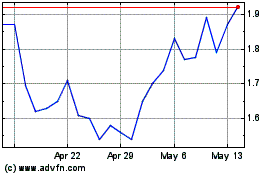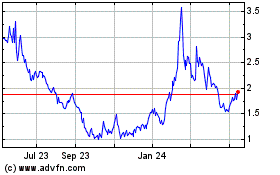Lexicon Pharmaceuticals, Inc. (Nasdaq: LXRX) today announced that a
post-hoc analysis of Phase 3 data from the SCORED clinical trial
demonstrated that INPEFA® (sotagliflozin) reduced the risk of major
adverse cardiovascular events (MACE) and heart failure (HF) events
across the spectrum of diabetes duration. Researchers noted that HF
patients with longer durations of diabetes derived greater benefit
from INPEFA, even controlling for similar baseline HbA1c, yet all
patients regardless of diabetes duration benefited from the
therapy. These findings were presented August 30th at the European
Society of Cardiology (ESC) Congress 2024 in London, United Kingdom
and online.
Diabetes duration is a well-established significant
risk factor for cardiovascular (CV) disease and its progression.
People with longer diabetes duration have a higher CV disease risk.
The objective of this analysis of SCORED, one of two pivotal
studies that led to FDA approval of INPEFA for heart failure in May
2023, was to evaluate if diabetes duration modifies the efficacy of
INPEFA. The primary endpoint was a composite of CV death, HF
hospitalization, and urgent heart failure visit events. Secondary
endpoints included MACE: CV death, nonfatal heart attack and
nonfatal stroke.
Study results showed treatment with INPEFA reduced
risk of MACE and HF events overall, plus an increasing benefit for
HF event reduction for patients with longer diabetes duration. In
SCORED, 10,579 (99.9%) of 10,584 patients had complete data on
diabetes duration, with 2412 (22.8%), 4424 (41.8%), 3743 (25.9%)
having diabetes duration of <10, 10-19, and ≥20 years
respectively. Median (Q1, Q3) diabetes duration was 16.4 years
(10.4, 22.4 years), while mean hemoglobin A1c was 8.6%, 8.7%, and
8.7% respectively by diabetes duration.
The rate of the primary endpoint was lower in the
INPEFA group (5.6 events per 100 patient-years [p-y]) compared with
the placebo group (7.5 events per 100 p-y) (HR: 0.74; 95% CI: 0.63,
0.88). Event rates among diabetes duration subgroups indicated that
rates in both the placebo group and relative treatment benefit
increased with increasing diabetes duration, with 5.6 vs 5.8 events
per 100 p-y, 6.1 vs 7.4 events per 100 p-y, and 4.6 vs 8.5 events
per 100 p-y for diabetes duration <10, 10-19, and ≥20 years
respectively. Spline analysis indicated increasing treatment
benefit with increasing duration when modeled continuously.
Similar findings were observed for the secondary HF
outcome of hospitalization for HF or urgent visit for HF, with
increased treatment benefit with increasing diabetes duration.
Total MACE was lower in the INPEFA group (4.8 events per 100
patient-years) than in the placebo group (6.3 events per 100
patient-years) (HR: 0.77; 95% CI: 0.65, 0.91), without significant
difference in relative treatment benefit by diabetes duration.
“This analysis reinforces clinical data previously
shared with the medical community showing that treatment with
INPEFA resulted in risk reductions for both heart failure and MACE
events in heart failure patients,” said Craig Granowitz, M.D.,
Ph.D., Lexicon’s senior vice president and chief medical officer.
“These benefits are critically important for patients, clinicians,
and payers, and they are key differentiators within the class of
SGLT2 inhibitors.”
About INPEFA®
(sotagliflozin)Discovered using Lexicon’s unique approach
to gene science, INPEFA® (sotagliflozin) is an oral inhibitor of
two proteins responsible for glucose regulation known as
sodium-glucose cotransporter types 2 and 1 (SGLT2 and SGLT1). SGLT2
is responsible for glucose and sodium reabsorption by the kidney
and SGLT1 is responsible for glucose and sodium absorption in the
gastrointestinal tract. Sotagliflozin has been studied in multiple
patient populations encompassing heart failure, diabetes, and
chronic kidney disease in clinical studies involving approximately
20,000 patients.
INDICATION
INPEFA is indicated to reduce the risk of
cardiovascular death, hospitalization for heart failure, and urgent
heart failure visit in adults with:
heart failure or
type 2 diabetes mellitus, chronic kidney disease,
and other cardiovascular risk factors
IMPORTANT SAFETY INFORMATION
Dosing: Assess renal function and volume status
and, if necessary, correct volume depletion prior to initiation of
INPEFA. INPEFA dosing for patients with decompensated heart failure
may begin when patients are hemodynamically stable, including when
hospitalized or immediately upon discharge.
Contraindications: INPEFA is contraindicated in
patients with hypersensitivity to INPEFA or any of its
components.
Ketoacidosis: INPEFA increases the risk of
ketoacidosis in patients with type 1 diabetes mellitus (T1DM). Type
2 diabetes Mellitus (T2DM) and pancreatic disorders are also risk
factors. The risk of ketoacidosis may be greater with higher doses.
There have been postmarketing reports of fatal events of
ketoacidosis in patients with type 2 diabetes using sodium glucose
transporter 2 (SGLT2) inhibitors. Before initiating INPEFA, assess
risk factors for ketoacidosis. Consider ketone monitoring in
patients with T1DM and consider ketone monitoring in others at risk
for ketoacidosis and educate patients on the signs/symptoms of
ketoacidosis. Patients receiving INPEFA may require monitoring and
temporary discontinuation of therapy in clinical situations known
to predispose to ketoacidosis. INPEFA is not indicated for glycemic
control.
Assess patients who present with signs and symptoms
of metabolic acidosis or ketoacidosis, regardless of blood glucose
level. If suspected, discontinue INPEFA, evaluate, and treat
promptly. Monitor patients for resolution of ketoacidosis before
restarting INPEFA.
Volume Depletion: INPEFA can cause intravascular
volume depletion which may sometimes manifest as symptomatic
hypotension or acute transient changes in creatinine. There have
been post-marketing reports of acute kidney injury, some requiring
hospitalization and dialysis, in patients with type 2 diabetes
mellitus receiving SGLT2 inhibitors. Patients with impaired renal
function (eGFR < 60 mL/min/1.73 m2), elderly patients, or
patients on loop diuretics may be at increased risk for volume
depletion or hypotension. Before initiating INPEFA in patients with
one or more of these characteristics, assess volume status and
renal function, and monitor for signs and symptoms of hypotension
during therapy.
Urosepsis and Pyelonephritis: Treatment with SGLT2
inhibitors, including INPEFA, increases the risk for urinary tract
infections. Serious urinary tract infections including urosepsis
and pyelonephritis requiring hospitalization have been reported.
Evaluate patients for signs and symptoms of urinary tract
infections and treat promptly.
Hypoglycemia with Concomitant Use with Insulin and
Insulin Secretagogues: Insulin and insulin secretagogues are known
to cause hypoglycemia. INPEFA may increase the risk of hypoglycemia
when combined with insulin or an insulin secretagogue. Therefore, a
lower dose of insulin or insulin secretagogue may be required to
minimize the risk of hypoglycemia when used with INPEFA.
Necrotizing Fasciitis of the Perineum (Fournier’s
Gangrene): Reports of Fournier’s Gangrene, a rare but serious and
life-threatening necrotizing infection requiring urgent surgical
intervention, have been identified in post-marketing surveillance
in patients with diabetes mellitus receiving SGLT2 inhibitors.
Assess patients who present with pain, tenderness, erythema, or
swelling in the genital or perineal area, along with fever or
malaise. If suspected, start treatment immediately with
broad-spectrum antibiotics and, if necessary, surgical debridement.
Discontinue INPEFA, closely monitor patient signs and symptoms, and
provide appropriate alternative therapy for heart failure.
Genital Mycotic Infections: INPEFA increases the
risk of genital mycotic infections. Monitor and treat as
appropriate.
Urinary Glucose Test and 1,5-anhydroglucitol
(1,5-AG) Assay: these are not reliable for patients taking SGLT2
inhibitors. Use alternative testing methods to monitor glucose
levels.
Common Adverse Reactions: the most commonly
reported adverse reactions (incidence ≥ 5%) were urinary tract
infection, volume depletion, diarrhea, and hypoglycemia.
Drug Interactions:
Digoxin: Monitor patients appropriately as there is
an increase in the exposure of digoxin when coadministered with
INPEFA 400 mg.
Uridine 5'-diphospho-glucuronosyltransferase (UGT)
Inducer: The coadministration of rifampicin, an inducer of UGTs,
with sotagliflozin resulted in a decrease in the exposure of
sotagliflozin.
Lithium: Concomitant use of an SGLT2 inhibitor with
lithium may decrease serum lithium concentrations. Monitor serum
lithium concentration more frequently during INPEFA initiation and
with dosage changes.
Use in Specific Populations:
Pregnancy and Lactation: INPEFA is not recommended
during the second and third trimesters of pregnancy, nor while
breastfeeding.
Geriatric Use: No INPEFA dosage change is
recommended based on age. No overall differences in efficacy were
detected between these patients and younger patients, and other
reported clinical experience has not identified differences in
responses between the elderly and younger patients, but greater
sensitivity of some older individuals cannot be ruled out. Elderly
patients may be at increased risk for volume depletion adverse
reactions, including hypotension.
Renal Impairment: INPEFA was evaluated in patients
with chronic kidney disease (eGFR 25 to 60 mL/min/1.73 m2) and in
patients with heart failure with eGFR < 60 mL/min/1.73 m2. The
safety profile of INPEFA across eGFR subgroups in these studies was
consistent with the known safety profile. There was an increase in
volume-related adverse events (e.g., hypotension, dizziness) in
patients with eGFR < 30 mL/min/1.73m2 relative to the overall
safety population. Efficacy and safety studies with INPEFA did not
enroll patients with an eGFR less than 25 mL/min/1.73 m2 or on
dialysis. After starting therapy in the studies, patients were
discontinued if eGFR fell below 15 mL/min/1.73 m2 or were initiated
on chronic dialysis.
Hepatic Impairment: INPEFA is not recommended in
patients with moderate or severe hepatic impairment.
Click here for full Prescribing
Information.
https://www.lexpharma.com/inpefa-US-PI.pdf
About Lexicon Pharmaceuticals
Lexicon is a biopharmaceutical company with a mission of pioneering
medicines that transform patients’ lives. Through the Genome5000™
program, Lexicon’s unique genomics target discovery platform,
Lexicon scientists studied the role and function of nearly 5,000
genes and identified more than 100 protein targets with significant
therapeutic potential in a range of diseases. Through the precise
targeting of these proteins, Lexicon is pioneering the discovery
and development of innovative medicines to treat disease safely and
effectively. Lexicon has commercially launched one of these
medicines, INPEFA® (sotagliflozin) in the United States, and has a
pipeline of other promising drug candidates in discovery and
clinical and preclinical development in neuropathic pain, diabetes
and metabolism and other indications. For additional information,
please visit www.lexpharma.com.
Safe Harbor Statement
This press release contains “forward-looking
statements,” including statements relating to Lexicon’s financial
position and long-term outlook on its business, including the
commercialization of its approved products and the clinical
development of, regulatory filings for, and potential therapeutic
and commercial potential of its other drug candidates. In addition,
this press release also contains forward looking statements
relating to Lexicon’s growth and future operating results,
discovery, development and commercialization of products, strategic
alliances and intellectual property, as well as other matters that
are not historical facts or information. All forward-looking
statements are based on management’s current assumptions and
expectations and involve risks, uncertainties and other important
factors, specifically including Lexicon’s ability to meet its
capital requirements, successfully commercialize its approved
products, successfully conduct preclinical and clinical development
and obtain necessary regulatory approvals of its other drug
candidates on its anticipated timelines, achieve its operational
objectives, obtain patent protection for its discoveries and
establish strategic alliances, as well as additional factors
relating to manufacturing, intellectual property rights, and the
therapeutic or commercial value of its approved products and other
drug candidates. Any of these risks, uncertainties and other
factors may cause Lexicon’s actual results to be materially
different from any future results expressed or implied by such
forward-looking statements. Information identifying such important
factors is contained under “Risk Factors” in Lexicon’s annual
report on Form 10-K for the year ended December 31, 2023, as filed
with the Securities and Exchange Commission. Lexicon undertakes no
obligation to update or revise any such forward-looking statements,
whether as a result of new information, future events or
otherwise.
For Investor and Media
Inquiries:Lisa DeFrancesco Lexicon Pharmaceuticals,
Inc.lexinvest@lexpharma.com
Lexicon Pharmaceuticals (NASDAQ:LXRX)
Historical Stock Chart
From Jan 2025 to Feb 2025

Lexicon Pharmaceuticals (NASDAQ:LXRX)
Historical Stock Chart
From Feb 2024 to Feb 2025
